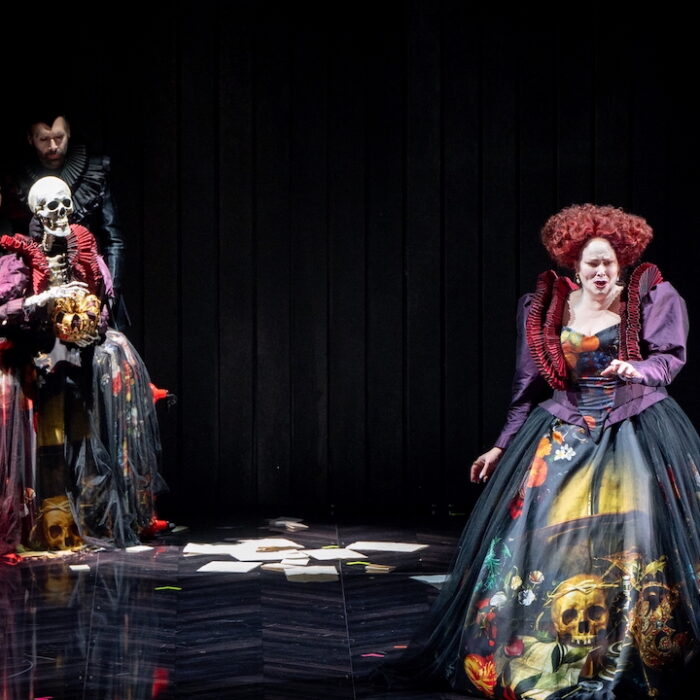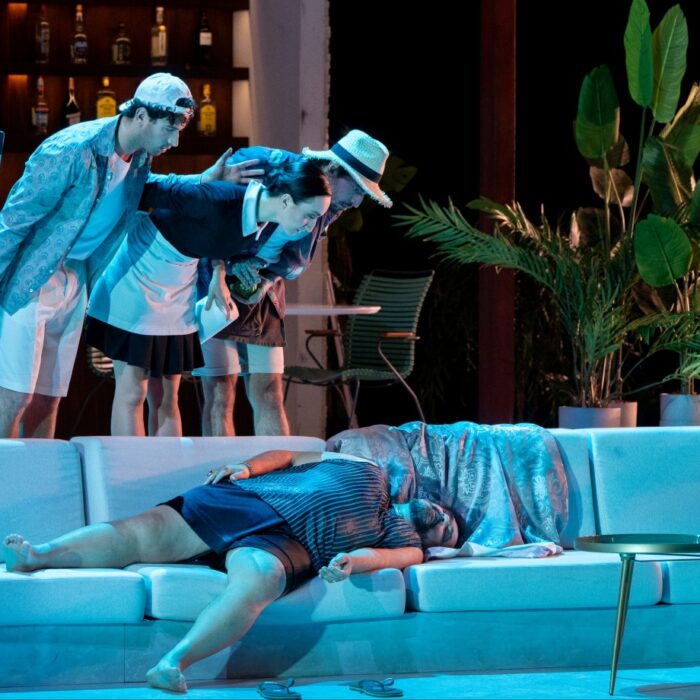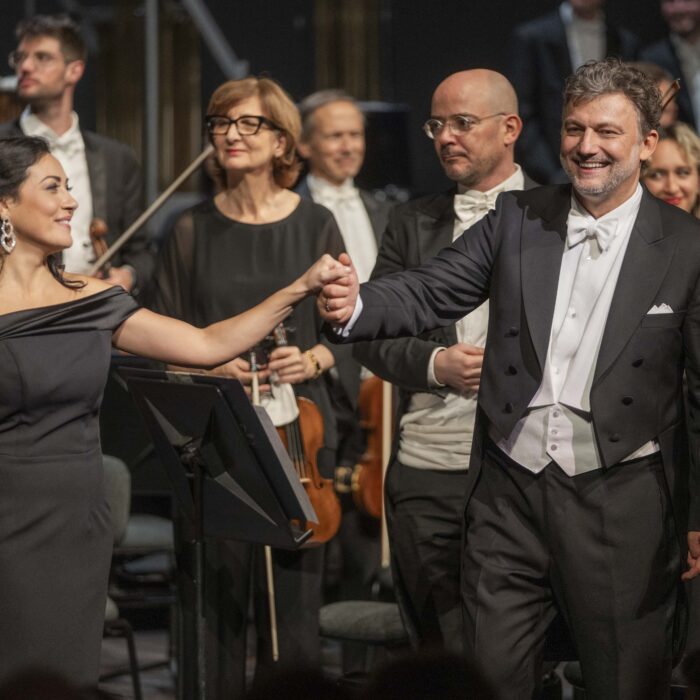
Rossini Opera Festival 2021 Review: Elisabetta Regina d’Inghilterra
Karine Deshayes Produces A Royal Performance As Queen Elizabeth II
By Alan Neilson(Photo: Amati Bacciardi)
“Elisabetta, Regina d’Inghilterra,” premiering in 1815, was Rossini’s first of eight operas for Naples’ Teatro di San Carlo. Having already established himself in Venice and Milan, he was set on conquering the Neapolitan public. This was no easy task, given the opposition he faced from the local cognoscenti. Such was his determination, however, he gave considerable attention to the enterprise, and for the first time wrote out all the vocal ornamentations and provided orchestral accompaniment for all the recitatives. He had an excellent cast available, including his future wife Isabella Colbran, and the libretto by Giovanni Schmidt allowed for the possibility of pitting two tenors and two sopranos against each other, for whom he wrote very demanding, dramatic, florid music. Reports suggest that he had already turned the audience in his favor before the first act had even finished. The evening ended in a triumph.
This year the Rossini Opera Festival, now in its 42nd year, presented its first production of the work under the musical direction of Evelino Pidò and stage direction of Davide Livermore.
Livermore Delves Into The Emotions
Possibly as a response to the popularity of the television series “The Crown,” Livermore decided to shift the drama from the 16th century to the mid-20th century so that Elizabeth I becomes the present queen, Elizabeth II. On the whole, this was not a bad idea, but obviously did give rise to certain anomalies, the most obvious being that today the Queen of England has very little formal power and the idea of her locking people in the Tower of London and having them tortured at will is far fetched, to say the least. Furthermore, from which war does Leicester return as a hero? Presumably, it would have to be World War II, which ended well before Elizabeth became queen. Certainly, he would not be returning from fighting the Scots! Be that as it may, ultimately it matters not. After all, the original libretto by Schmidt is also largely one of fiction.
Aided by scenographer Giò Forma, costume designer Gianluca Falaschi and Video designer D-WOK, Livermore created a fast-moving staging, which was forever in a state of flux. Some scenes were aesthetically very pleasing indeed, such as the Act one court scene in which the women were dressed in 1950s soft-colored gowns. Some scenes were forgettable, while others were simply confusing, as in the Royal Apartment scene in which a green hill appeared at the back of the stage, upon which flowers burst into bloom. The overriding concern, however, appeared to be to depict the changing emotional and psychological states of the Queen and the principal characters, to which end the stage was covered in oddly-shaped and lop-sided furniture. The use of imaginative video images also proved very effective in this respect, in which Livermore made use of extreme weather conditions, such as menacing dark clouds swirling around in the background, or raging waters flooding London.
This is not to say that the use of video was restricted to depicting the hidden depths of the characters alone. As the court awaited the arrival of Leicester, for example, we see his face projected against a cloudy sky, the conquering hero returning to a grateful people, in what was an image very much suggestive of fascist or militaristic iconography.
Livermore also appeared to enjoy including as many symbols of Britain—not just England—into his staging as was possible, such as the Union Jack, Tower Bridge, bowler hats and umbrellas, spitfires, the lions from Trafalgar Square, and of course, England’s foremost icon, Queen Elizabeth II herself, in her regal costume.
Less Would Have Been More
Overall, the staging demanded too much of itself, and occasionally ended up distracting from, rather than supporting, the drama, albeit with some excellent images or scenes emerging from the flux. Rarely was anything allowed to settle, movement and change dominated. It was definitely a case in which less would have been more.
The conductor Evelino Pidò elicited a vibrant and rhythmically taut performance from the Orchestra Sinfonica Nazionale Della RAI, in which individual numbers displayed a pleasing balance between the orchestra and the singers, and between the individual singers during ensembles, where no single voice was allowed to unduly dominate. Moreover, Pidò was attentive to the textural detail and brought out the interesting colors of the score. However, there were periods of languor, especially during the passages of recitative, which disrupted the overall musical sweep.
Deshayes Rules Over Her Court
In the titular role was French mezzo-soprano Karine Deshayes, who produced a striking visual representation of current Queen Elizabeth, which she backed up with an acting performance that captured the regal nature of her character, including the appropriate gestures expected from someone confident and secure in their position of authority. Her vocal presentation was equally convincing, although one which tended to promote the dramatic and expressive rather than the vocal beauty of bel canto, but it was a decision in line with the overall production’s aesthetic which aimed at uncovering the emotional depths of the characters. Her opening aria “Quant’è grato all’alma mia” immediately showed off the strength, delicacy, and flexibility of her voice, particularly in the cabaletta. Here her voice danced along the melody and her coloratura shone brightly. It was in the ensembles, however, in which Deshayes was particularly impressive as she engaged so convincingly with the other characters. In the Act one finale, in which her meeting with Leicester descends into confrontation, Deshayes produced a formidable vocal display where she gave expression to a wide range of emotions, culminating with her voice soaring above the surrounding musical forces which, although sounding a little harsh, did not lack for power or emotional punch.
Her Subjects Produce Fine Performances
Soprano Salome Jicia cast in the role of Matilde proved herself to be a worthy opponent to Deshayes’ Elisabetta. The first scene of Act one, including the duet “Penso ache sol per poco” proved to be one of the highlights of the evening, with both women engaging head on and in which Matilde is eventually reduced to tears. Jicia’s ability to explore the emotions of her character were vividly on display, as she inflected the voice with emotional and colorful emphases as she implored the Queen to show mercy. Her presentation of her aria “Sento un’intera voce,” in which she ponders on the suffering that awaits her, was no less effective. Against a projection of a black abyss, Jicia produced an expressive rendition, which showcased her wonderfully detailed phrasing and vocal agility in a series of coloraturas.
Tenor Sergey Romanovsky produced a lyrically engaging presentation as Leicester, in which his acting and singing successfully captured the swagger of the returning hero. He possesses a well-supported voice, with a pleasing timbre that he used to good effect, no more so than in the prison scene in which his expressive recitatives captured his weary and forlorn state. From here he moved into the aria “Sposa amata…respira…,” in which he gave voice to his anxiety and sorrow in a powerfully rendered and emotional presentation, which also showed off the beauty of his singing. His ensemble singing also displayed quality. The scena and duet with Matilde, beginning “Incauta, che festi!,” was also wonderfully presented, with both Romanovsky and Jicia producing strong, lyrical performances in which their voices combined to complement each other splendidly.
In the role of Norfolc was tenor Barry Banks. His performance was somewhat mixed, unfortunately. His voice is beginning to show signs of aging, such as diminished projection in the longer passages and a thinning of the voice when under pressure. Yet there was still much to admire about his performance. His recitative and duet with Elisabetta starting “Colmo di duol, Regina” was expertly sung, his coloratura showing off his still-considerable vocal flexibility. Likewise, his scena and aria “Che intesi! … oh annunzio!” which he presented standing in front of the orchestra, showed his skill in vocal characterization. Here he totally convinced in presenting Norfolc as thoroughly evil, akin to an Iago-type figure.
Matilde’s brother Enrico was played by mezzo-soprano Marta Pluda. She made a strong impression in which her expressive recitatives and lively ensemble singing caught the attention of all.
The Captain of the Guard Guglielmo was played by tenor Valentino Buzza, who produced a solid performance.
The Coro del Teatro Ventidido Basso were well-drilled by the Maestro del Coro Giovanni Farina, producing a vibrant and dramatically sensitive performance.
Overall, this was a beautifully sung presentation with some excellent individual performances. It was the ensemble singing, however, which stood out overall. Although the fast-moving staging suffered from too many ideas, all of which demanded attention, it did support the drama, but it did need to be kept at arms length, as it was too easy to become stuck on a particular image, owing either to its opaque meaning or to its visual impact.



